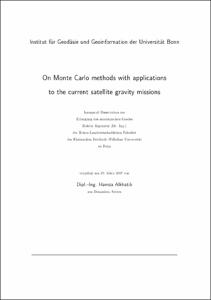On Monte Carlo methods with applications to the current satellite gravity missions

On Monte Carlo methods with applications to the current satellite gravity missions

| dc.contributor.advisor | Schuh, Wolf-Dieter | |
| dc.contributor.author | Alkhatib, Hamza | |
| dc.date.accessioned | 2020-04-09T07:29:18Z | |
| dc.date.available | 2020-04-09T07:29:18Z | |
| dc.date.issued | 2007 | |
| dc.identifier.uri | https://hdl.handle.net/20.500.11811/2713 | |
| dc.description.abstract | Large-scaled least squares problems require tailored numerical techniques to overcome the computational burden. For these types of problems iterative strategies are suitable because of their flexibility and effectiveness. The first shortcoming of iterative strategies in least squares estimation is the fact that the inverse of the normal equation matrix as the carrier of the covariance information is not available or very expensive to compute. Another shortcoming within iterative strategies arises when different types of observation groups with different stochastic properties are to be combined. In this case the choice of optimum weight factors, and eventually regularization parameters, by means of variance component estimation is essential for obtaining reliable estimates of the unknown parameters. Unfortunately, the conventional method of variance component estimation requires the repeated inversion of large products of matrices. This thesis presents algorithms based on Monte Carlo methods, which can be integrated very efficiently into iterative solvers, and which are demonstrated to close the aforementioned gaps. Tailored strategies for different types of solution techniques with respect to normal equations, observation equations and combined models are treated. In addition, the thesis presents new criteria to define confidence regions of the estimated variance information of the parameters, as well as for all additional derived quantities. The developed algorithms for computing variance/covariance matrices and for obtaining variance components are tailored to be integrated into the Preconditioned Conjugate Gradients Multiple Adjustment (PCGMA) algorithm of Schuh (1996) and Boxhammer (2006). These algorithms are applied in a case study to simulated GOCE data, where Satellite Gravity Gradiometry (SGG) data in form of observation equations and Satellite-to-Satellite tracking (SST) data in form of normal equations are combined for recovering the Earth's gravity field. | en |
| dc.description.abstract | Zu Monte Carlo Methoden mit Anwendungen in aktuellen Schwerefeldsatellitenmissionen In großdimensionierten Ausgleichungsproblemen lassen sich die numerischen Kosten oft nur mit speziell angepassten Techniken in erträglichen Grenzen halten. Iterative Strategien sind hier aufgrund ihrer Flexibilität und Effizienz besonders geeignet. Allerdings wird dabei der Gewinn an Rechenzeit mit einem Verlust an Information erkauft, da iterative Löser zumeist nicht effizient sind, um die Varianz-Kovarianz-Matrix der Unbekannten zu liefern. Ein weiterer Nachteil zeigt sich, wenn Beobachtungsgruppen mit unterschiedlichen stochastischen Eigenschaften miteinander kombiniert werden sollen. In diesem Fall ist es notwendig, die optimalen Gewichtungsfaktoren - eventuell auch Regularisierungsparameter - über die Schätzung von Varianzkomponenten zu bestimmen. Die herkömmliche Methode der Varianzkomponentenschätzung erfordert dabei die wiederholte Inversion großer Matrizen. In dieser Arbeit wird gezeigt, daß sich diese Probleme mit auf Monte-Carlo-Methoden basierenden Algorithmen lösen lassen, die sehr effizient in iterative Löser integriert werden können. Speziell angepasste Algorithmen für Löser, die verschiedene Beobachtungsgruppen sowohl auf Basis von Normalgleichungen als auch auf Basis von Beobachtungsgleichungen oder auch Kombinationen von Beobachtungs- und Normalgleichungen verarbeiten können, werden vorgestellt. Darüber hinaus werden in dieser Arbeit neue Kriterien angegeben, mit denen Konfidenzintervalle für die Varianzinformation der geschätzten Parameter und auch aller abgeleiteten Größen angegeben werden können. Die entwickelten Algorithmen zur Berechnung der Varianz-Kovarianz-Matrizen und zur Schätzung der Varianzkomponenten werden in den PCGMA-Algorithmus von Schuh (1996) und Boxhammer (2006) integriert. Sie werden auf ein Testszenario mit simulierten GOCE-Daten angewendet, in dem zur Bestimmung des Erdschwerefeldes "Satellite Gravity Gradiometry"-Daten auf Basis von Beobachtungsgleichungen mit "Satellite-to-Satellite-Tracking"-Daten auf Basis von Normalgleichungen miteinander kombiniert werden. | en |
| dc.language.iso | eng | |
| dc.rights | In Copyright | |
| dc.rights.uri | http://rightsstatements.org/vocab/InC/1.0/ | |
| dc.subject | Monte Carlo | |
| dc.subject | GOCE | |
| dc.subject | Varianzkomponenten | |
| dc.subject | variance components | |
| dc.subject.ddc | 550 Geowissenschaften | |
| dc.title | On Monte Carlo methods with applications to the current satellite gravity missions | |
| dc.type | Dissertation oder Habilitation | |
| dc.publisher.name | Universitäts- und Landesbibliothek Bonn | |
| dc.publisher.location | Bonn | |
| dc.rights.accessRights | openAccess | |
| dc.identifier.urn | https://nbn-resolving.org/urn:nbn:de:hbz:5N-10783 | |
| ulbbn.pubtype | Erstveröffentlichung | |
| ulbbnediss.affiliation.name | Rheinische Friedrich-Wilhelms-Universität Bonn | |
| ulbbnediss.affiliation.location | Bonn | |
| ulbbnediss.thesis.level | Dissertation | |
| ulbbnediss.dissID | 1078 | |
| ulbbnediss.date.accepted | 01.06.2007 | |
| ulbbnediss.fakultaet | Landwirtschaftliche Fakultät | |
| dc.contributor.coReferee | Kusche, Jürgen |
Dateien zu dieser Ressource
Das Dokument erscheint in:
-
E-Dissertationen (1120)




